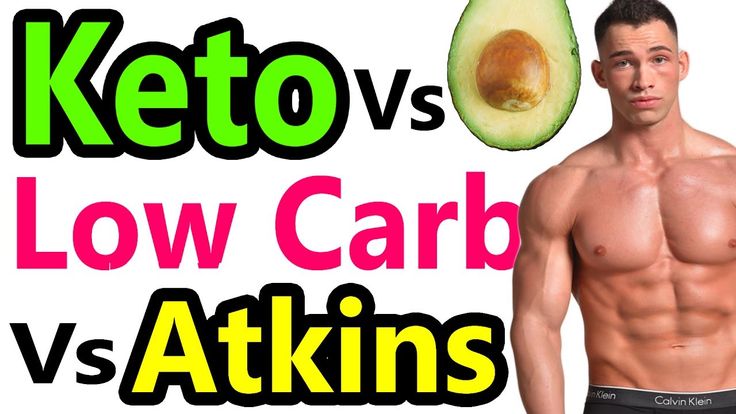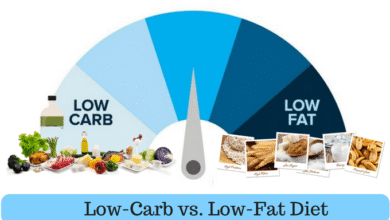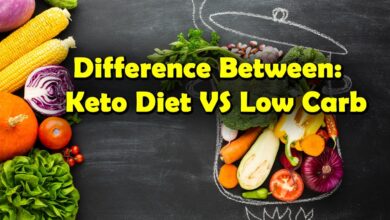
Deciding whether to go keto or adopt a low-fat diet can feel like standing at a crossroads with no map. Both approaches promise better health, more energy, and weight loss — but which truly suits you? In this deep dive, I’ll walk you through 8 essential tips for picking between keto and low-fat diets tips. We’ll explore science, sustainability, personal preferences, and real-world practicalities. Read on, and you’ll be empowered to make a choice that’s not just trendy — but optimal for your life.
Read Also How to Achieve Long-Term Weight Loss: Keto vs Low-Fat — Which Works Best?
1. Understand the Fundamentals: What Are Keto and Low-Fat Diets?
Before you can choose between them, you need clarity on what each one actually is — and what your body “expects” from you.
- The ketogenic (keto) diet is a high-fat, moderate-protein, very-low-carbohydrate plan. Typical macros might be 70–80% of your calories from fats, 15–25% from protein, and only 5–10% from carbs. By severely limiting carbs, your body enters ketosis, burning fat instead of glucose as its primary fuel.
- The low-fat diet flips that formula. Here, you get most energy from carbohydrates and proteins, while restricting fats — often limiting fat intake to 20–30% (or lower) of total calories. The idea is that by reducing fat (especially saturated fat), you reduce calorie density and potentially improve cardiovascular markers.
Why these differences matter: Your metabolic responses, satiety levels, cravings, energy stability, and even mood might shift dramatically depending on which side you lean.
2. Evaluate Your Health Goals and Medical Background
Your personal goals and health history should heavily influence which diet you adopt.
- Weight loss: Keto often delivers faster initial weight loss, in part because of water loss and appetite suppression. But low-fat diets can also be effective, especially long term.
- Cholesterol, blood lipids, heart health: Some people respond poorly to high saturated fat intake, seeing LDL cholesterol spikes on keto. If you have a history of hypercholesterolemia or heart disease, a low-fat route may be safer.
- Diabetes, insulin resistance, metabolic syndrome: Keto can dramatically reduce blood sugar and insulin levels, which is a big advantage. Low-fat diets can also help, but often more gradually.
- Digestive health: High fat loads in a keto diet might stress your gallbladder or bile function; conversely, very low fat in a low-fat diet might lead to deficiencies in fat-soluble vitamins (A, D, E, K).
- Thyroid or hormonal issues: Extreme carb restriction sometimes has negative impacts on thyroid hormones in susceptible individuals.
- Sustainability and mental health: A plan that you can stick with (not drive you crazy) is the best health plan.
In short: map the diet to your goals and your body’s unique context.
3. Test Your Tolerance for Carbs and Fats (Experiment Safely)
One useful tip: treat one diet as a trial rather than a permanent commitment — see how you respond in 4–8 weeks.
- On keto, monitor your energy, mood, digestive regularity, and blood lipids (if possible). Some people feel amazing — sustained energy, no sugar cravings, sharper focus. Others feel sluggish or constipated.
- On low-fat, notice hunger levels, blood sugar fluctuations, mood swings, and whether cravings for fatty or sugary foods intensify.
Keep a food & symptom journal. Track metrics like weight, waist circumference, how often you feel hungry, how restful your sleep is. After the trial, compare how you felt and how your body responded.
4. Pay Attention to Satiety, Hunger, and Cravings
A diet that leaves you ravenous is going to fail. One of the most telling metrics is how full you feel.
- Keto’s advantage: Fat is calorie-dense and can produce strong satiety. Many people report fewer hunger pangs and reduced snacking mindlessly.
- But caution: if you skimp on protein or enough volume (fiber, veggies), cravings may still arise.
- Low-fat challenges: carbs digest quickly, sometimes causing faster dips in blood sugar — which can lead to hunger or sugar cravings. But if you load the diet with complex carbs (legumes, whole grains, fibrous vegetables) and protein, hunger may be well controlled.
Essentially: run a “hunger audit.” Notice how often you think about food, how soon after a meal you get hungry again, and whether you experience cravings for sweet or high-fat foods.
5. Account for Social, Culinary, and Lifestyle Preferences
You may have a perfect metabolism for keto — but if your social life is impossible to reconcile with it, your diet will crater.
- Do you dine out frequently? Keto can be more restrictive (high fat, low carb) and may cause more “exceptions” or slip-ups. Low-fat offers more flexibility (rice, bread, pasta) — though portion control is still critical.
- Do you love high-fat foods (nuts, cheese, avocado, oils) or thrive on grains, fruits, and legumes? Choose the path that aligns with your palate.
- What’s your cooking and grocery budget? Keto often leans on more expensive ingredients (quality oils, grass-fed meats, nuts). Low-fat diets can leverage plant staples that are economical and abundant.
- Travel, holidays, family meals: Which diet is easier to “pause” or modify temporarily without stress? The more forgiving, the better sustainability.
Your lifestyle is as crucial as your biology.
6. Consider Long-Term Sustainability and Nutrient Adequacy
A diet that works for three months but collapses after six isn’t victory. You must plan for the long haul.
- Micronutrients: Keto may underdeliver fiber, B vitamins, and minerals found in whole grains and legumes. You might need more veggies, nuts, and supplements. Low-fat diets may struggle with fat-soluble vitamins (if fat is too restricted).
- Variety and enjoyment: Over time, monotony is a recipe for failure. Keto can feel repetitive if over-relying on fats and meats. Low-fat can feel bland if you lean too heavily on boiled veggies.
- Metabolic adaptation: Some users on long-term keto report plateaus or fatigue. Low-fat dieters may hit metabolic slowdown too, but perhaps less dramatically.
- Flexibility: Some hybrid or cyclical approaches (e.g. moderate-carb, moderate-fat) might allow long-term adherence better than the extremes.
- Health markers: Track your lipids, liver enzymes, kidney function, thyroid, and more periodically. Let data guide whether to continue, modify, or pivot.
Always ask: will I still want to do this in months?
7. Use Data, Not Dogma — Biomarkers and Self-Tracking
Rely on evidence from your own body, not social media gurus or diet wars.
- Get baseline labs: fasting glucose, HbA1c, LDL/HDL/triglycerides, liver enzymes, thyroid, kidney markers, and inflammatory markers (e.g. CRP).
- Use non-lab feedback: energy levels, mood, skin, digestion, sleep quality, menstrual cycles (if applicable).
- Consider tools like continuous glucose monitors (CGMs), wearables, smart scales, or periodic ketone testing (blood or breath).
- Adjust based on trends: for instance, if your LDL dramatically worsens on keto, you might shift to a lower-fat or more moderate-fat approach.
- Don’t get stuck on one “side.” Some days or phases may call for more carbs; others may favor more fats. You can modulate.
The most robust diet is one you can adjust dynamically based on real feedback.
8. Plan for a Smart Transition or Hybrid Approach
You don’t necessarily have to choose one rigidly. A smart transition or hybrid model may combine the best of both worlds.
- Phased approach: Start with keto for 4–8 weeks, then gradually introduce healthy carbs (e.g. legumes, quinoa, sweet potatoes) while slightly reducing fats — finding a middle ground.
- Cyclical keto: Some do keto during the week, and allow moderate carbs on weekends or special days.
- Moderate / flexible diet: Aim for a macronutrient balance that’s middle-of-the-road (e.g. 40% carbs, 35% fats, 25% protein) — sometimes called a “balanced low-carb” approach.
- Refeeds or carb-up days: Planned interruptions to break metabolic adaptation and support women’s hormonal cycles.
- Seasonal or context-based shifts: For instance, more carbs on workout days or when travel demands higher flexibility, and lower carbs during sedentary periods.
This is not “cheating” — it’s smart adaptability. Think like a body electrician, not a diet dictator.
Additional Subtopics & Deep Dives
The Science Behind Keto vs Low-Fat — What Research Says
Over the years, many randomized controlled trials and meta-analyses have compared low-carb (keto-ish) diets with low-fat diets. Results often show early weight loss advantages for low-carb plans; however, at 12 months or longer, differences tend to shrink. Some participants on low-fat catch up. The key predictors of success often aren’t macro ratios but adherence, quality of food, and energy balance.
Moreover, individual response (“metabolic phenotype”) is critical — some are “carb-tolerant” and do fine on moderate carbs, others respond better to lower-carb regimens. Also, gene–diet interactions, insulin sensitivity, and microbiome variation may influence which approach works best.
Managing Common Side Effects and Transition Challenges
- On keto: “keto flu” (headaches, fatigue, irritability) often occurs early. Combat it with electrolytes (sodium, potassium, magnesium), hydration, and gradual carb drop.
- On low-fat: early hunger or cravings for fats might appear. Use whole foods, fiber, lean proteins, and healthy fat “spices” (e.g. small amounts of olive oil) to mitigate.
- Plateaus: after initial progress, any diet hits stalls. Use calorie cycling, intermittent fasting, or macro tweaks.
- Social pressure: be ready with polite responses — “I’m trying a new eating plan — it’s temporary / tailored to me.”
- Nutrient deficiencies: supplement when needed (e.g. omega-3s, vitamin D, iodine) and rotate food sources.
Sample Meal Structures for Each Approach
Low-fat day (moderate calorie):
- Breakfast: oatmeal with berries + fat-free Greek yogurt + sprinkle of flaxseeds
- Lunch: grilled chicken breast, big salad with beans, lemon-tahini (low-fat) dressing
- Snack: fruit + rice cakes + low-fat cottage cheese
- Dinner: steamed fish, quinoa, steamed greens
Keto day:
- Breakfast: scrambled eggs + spinach + avocado + butter
- Lunch: grilled salmon + mixed greens + olive oil + nuts
- Snack: macadamia nuts or cheese slices
- Dinner: roast chicken thigh + cauliflower mash + sautéed kale in coconut oil
How to Calculate Your Macros for Each Diet
- Estimate your total daily energy expenditure (TDEE) via online calculators.
- Then set macros:
– Keto: 70–80% fat, 15–25% protein, 5–10% carbs (measured in grams)
– Low-fat: 55–65% carbs, 20–25% protein, 15–25% fat - Use apps like MyFitnessPal or Cronometer to log intake.
- Adjust weekly based on weight trends and subjective feedback.
Dealing With Psychological and Behavioral Factors
Your mindset matters. Diet wars often induce guilt, binge cycles, or all-or-nothing thinking.
- Use habit first approach: build consistency before perfection.
- Allow occasional flexibility — an occasional small “treat” doesn’t wreck long-term progress.
- Don’t compare yourself to others. Your biology, preferences, and life are unique.
- Work on stress, sleep, and emotions — diet is just one piece of the puzzle.
Conclusion
Choosing between a keto diet and a low-fat diet isn’t about jumping on a fad — it’s about matching your body, goals, lifestyle, and preferences to a plan you can sustain. Use these 8 tips as your guide: understand fundamentals, align with your health context, test your responses, monitor satiety, factor in lifestyle, plan for sustainability, track your data, and allow hybrid transitions. Over time, your ideal path might shift — and that’s perfectly okay. Stay flexible, stay curious, and make adjustments based on what you experience.
Read Also Keto vs. Low-Fat Diet: How to Evaluate Which Plan Fits You Best
FAQs
Q1: Which diet is better for rapid weight loss — keto or low-fat?
A1: Keto often yields faster initial weight loss, partly due to water loss and appetite suppression. But in 6–12 months, low-fat diets can produce similar results if adhered to. The real winner is the diet you can stick with.
Q2: Can I get heart disease risk on a keto diet because of saturated fats?
A2: It depends. Some respond to saturated fats with LDL increases; others don’t. If you have preexisting heart disease or high cholesterol, monitor your lipid panel. Opt for more unsaturated fats (olive oil, nuts, fish) rather than lots of butter and processed meats.
Q3: Can a low-fat diet cause nutrient deficiencies?
A3: If fat intake is too low, absorption of fat-soluble vitamins (A, D, E, K) may suffer. You might also miss out on omega-3 fatty acids. Including small healthy fats (e.g. olive oil, flax, fatty fish) or supplements can protect you.
Q4: Do I have to stay on one diet forever?
A4: No. Many people find their best results through flexible or hybrid approaches — cycling carbs, modifying macros over time, or blending keto and low-fat phases.
Q5: How long should I test one diet before judging its effectiveness?
A5: Give any diet at least 4 to 8 weeks (with consistent adherence) before evaluating results. This allows your body time to adapt and gives you sufficient data (weight, energy, labs) to compare meaningfully.




